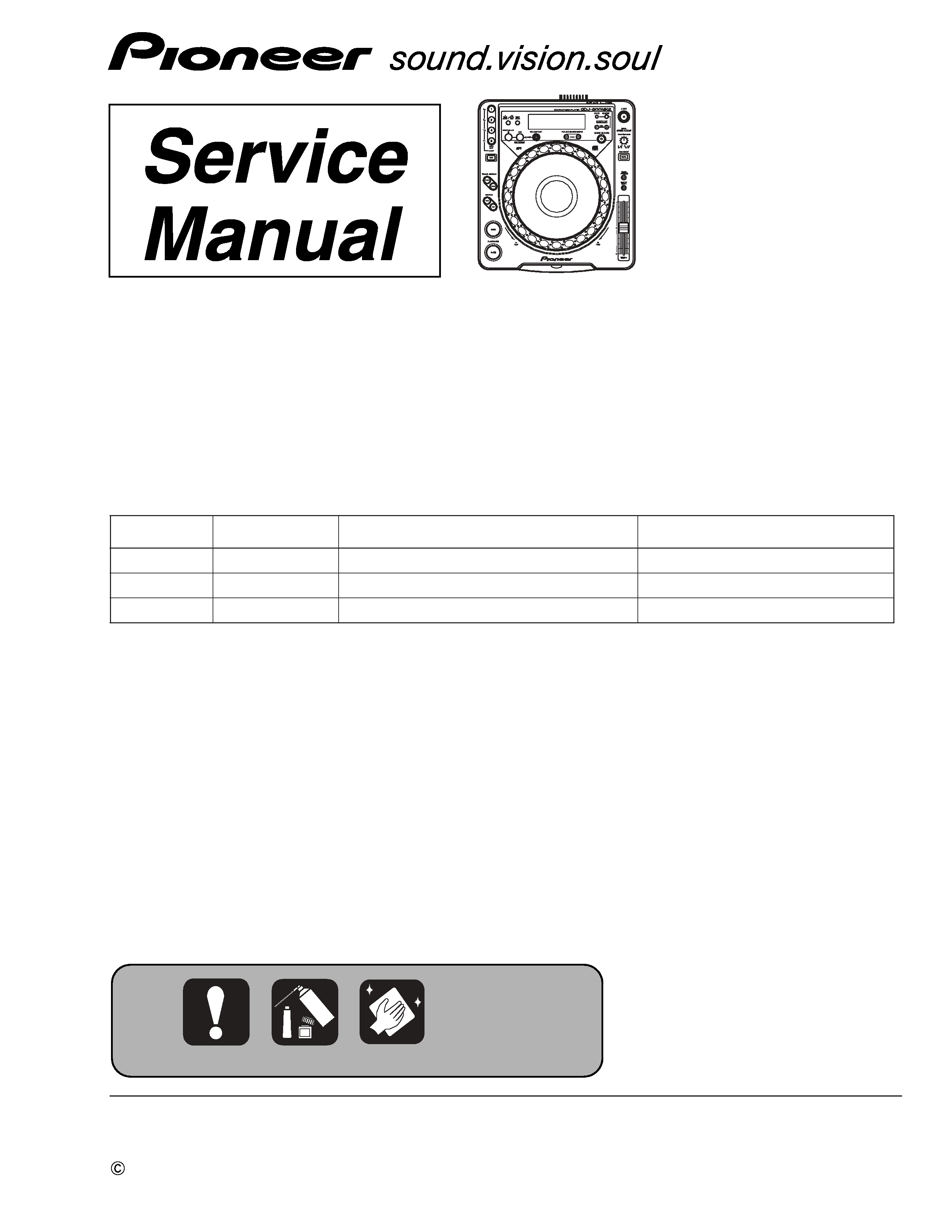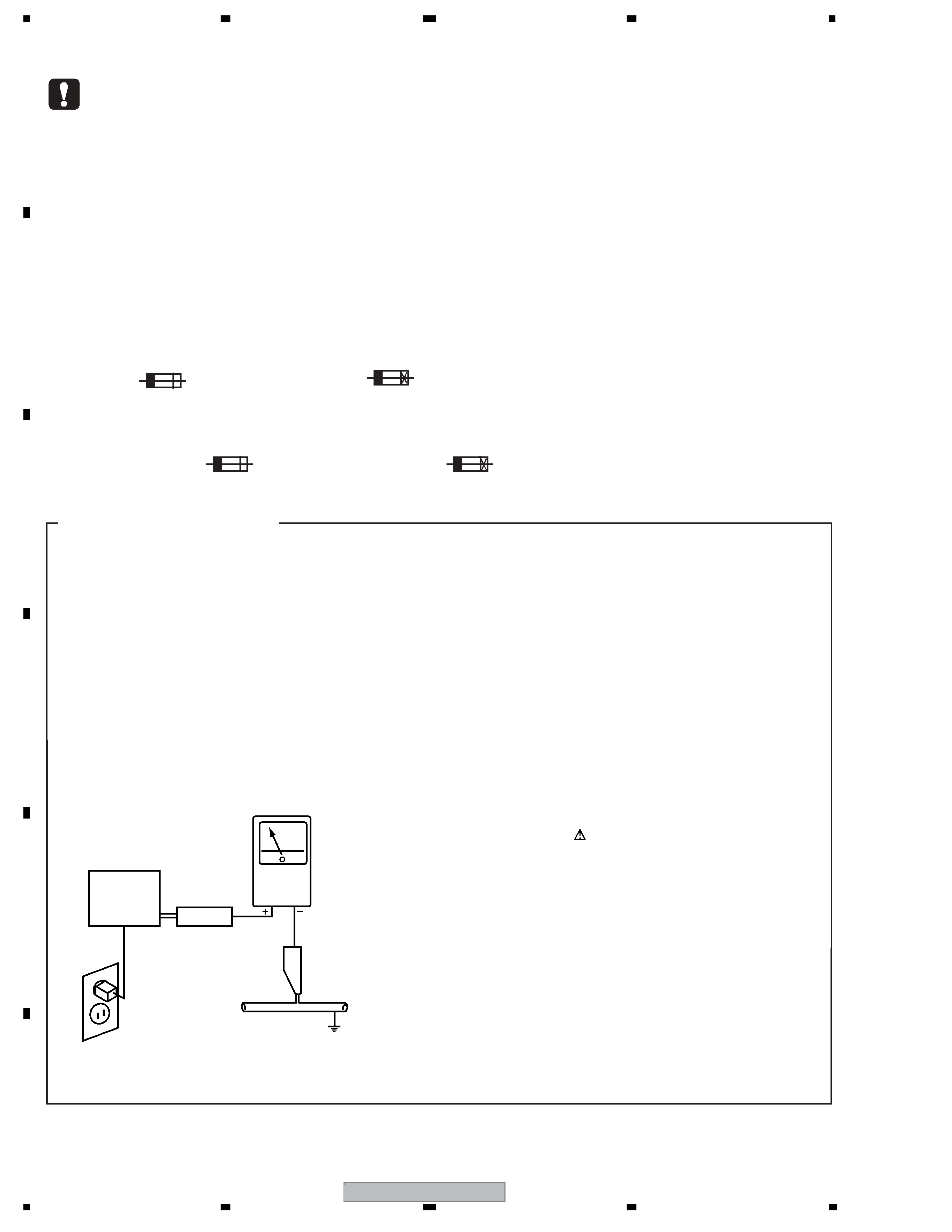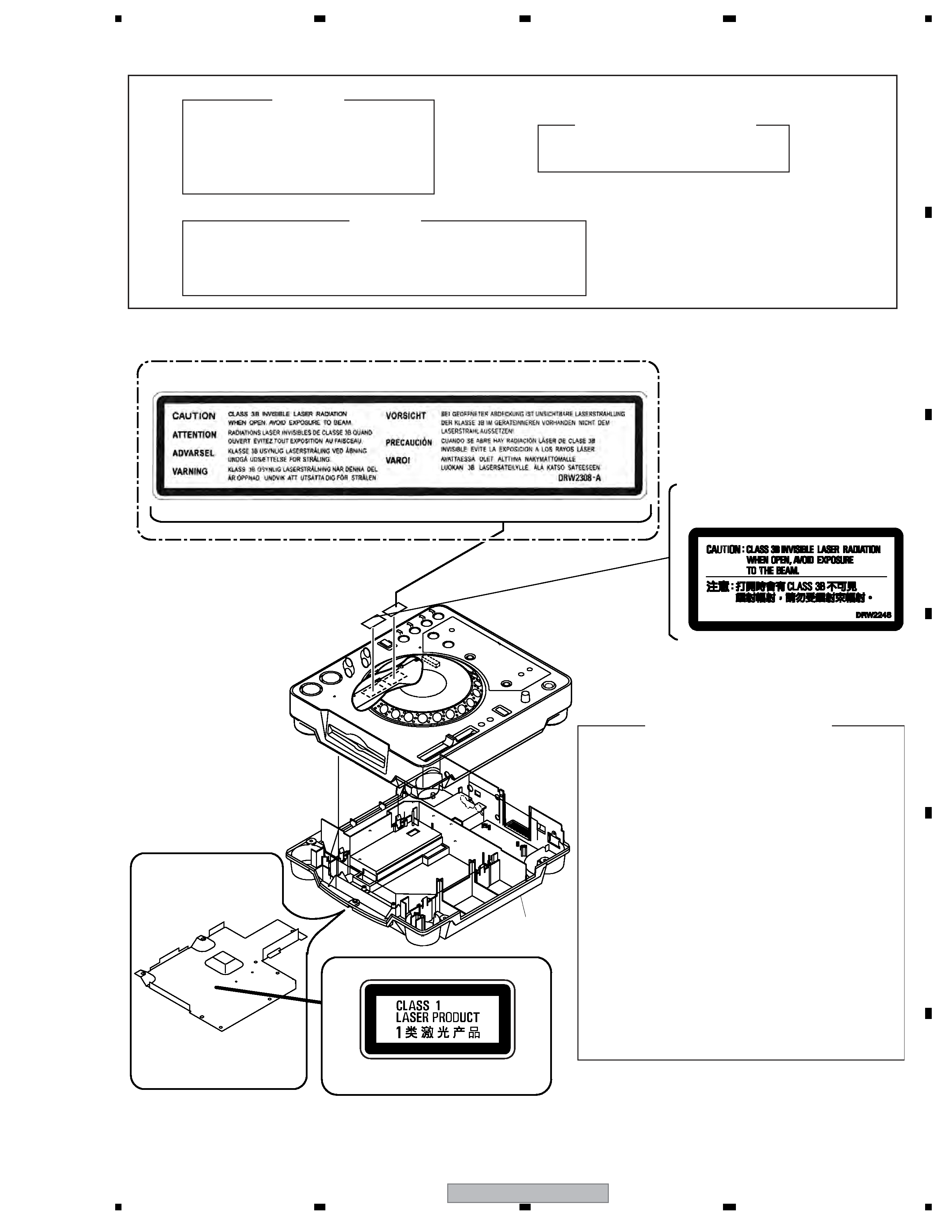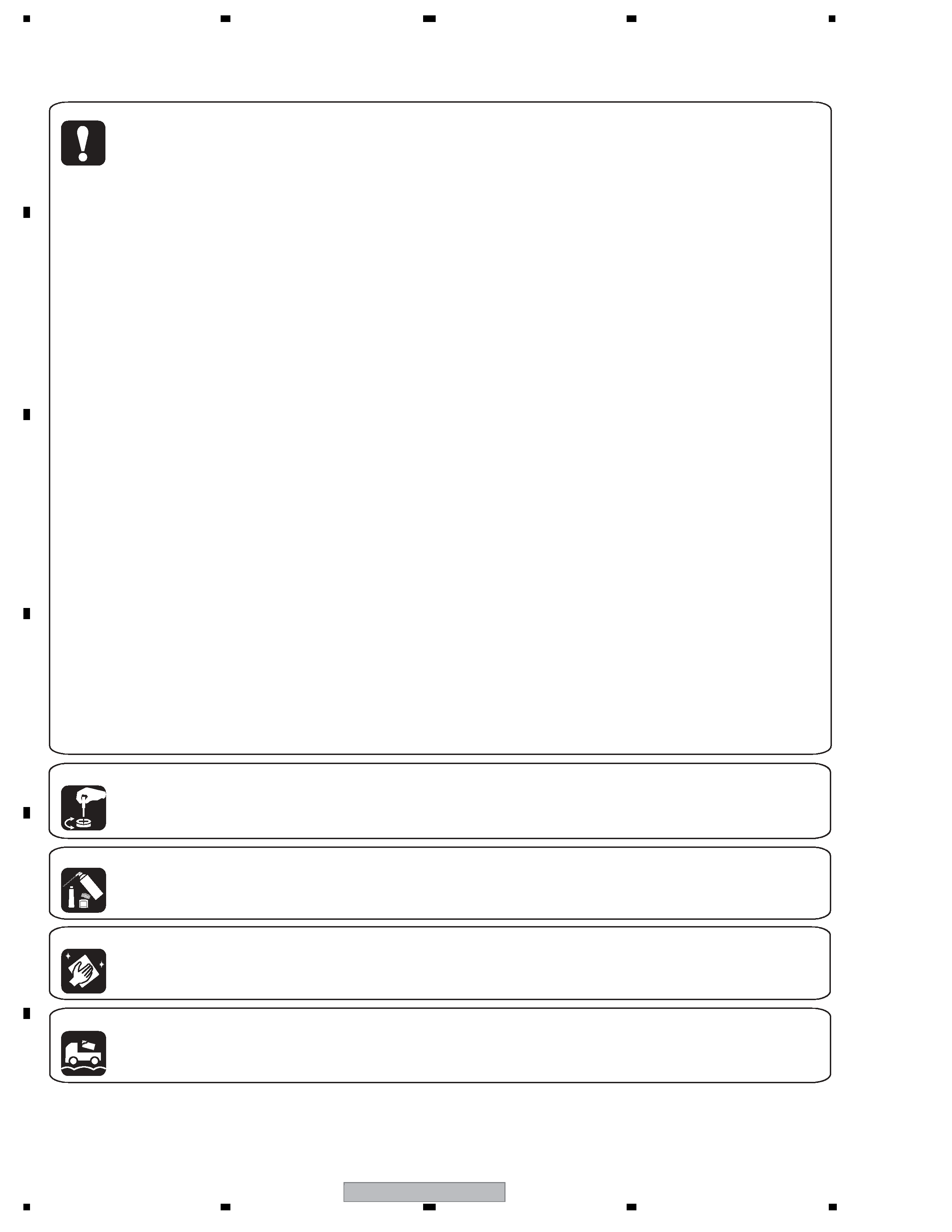
ORDER NO.
PIONEER CORPORATION 4-1, Meguro 1-chome, Meguro-ku, Tokyo 153-8654, Japan
PIONEER ELECTRONICS (USA) INC. P.O. Box 1760, Long Beach, CA 90801-1760, U.S.A.
PIONEER EUROPE NV Haven 1087, Keetberglaan 1, 9120 Melsele, Belgium
PIONEER ELECTRONICS ASIACENTRE PTE. LTD. 253 Alexandra Road, #04-01, Singapore 159936
PIONEER CORPORATION 2006
CDJ-800MK2
RRV3364
COMPACT DISC PLAYER
CDJ-800MK2
THIS MANUAL IS APPLICABLE TO THE FOLLOWING MODEL(S) AND TYPE(S).
Model
Type
Power Requirement
Remarks
CDJ-800MK2
KUCXJ
AC 120 V
CDJ-800MK2
WYXJ5
AC 220 240 V
CDJ-800MK2
RLFXJ
AC 110-120 V / 220-240 V
For details, refer to "Important symbols for good services" .
T-ZZR JUNE 2006 printed in Japan

CDJ-800MK2
2
12
34
12
3
4
C
D
F
A
B
E
SAFETY INFORMATION
This service manual is intended for qualified service technicians ; it is not meant for the casual do-it-
yourselfer. Qualified technicians have the necessary test equipment and tools, and have been trained
to properly and safely repair complex products such as those covered by this manual.
Improperly performed repairs can adversely affect the safety and reliability of the product and may
void the warranty. If you are not qualified to perform the repair of this product properly and safely, you
should not risk trying to do so and refer the repair to a qualified service technician.
WARNING
This product contains lead in solder and certain electrical parts contain chemicals which are known to the state of California to
causecancer, birth defects or other reproductive harm.
Health & Safety Code Section 25249.6 Proposition 65
NOTICE
(FOR CANADIAN MODEL ONLY)
Fuse symbols
(fast operating fuse) and/or
(slow operating fuse) on PCB indicate that replacement
parts must be of identical designation.
REMARQUE
(POUR MODÈLE CANADIEN SEULEMENT)
Les symboles de fusible
(fusible de type rapide) et/ou
(fusible de type lent) sur CCI indiquent que
les pièces de remplacement doivent avoir la même désignation.
ANY MEASUREMENTS NOT WITHIN THE LIMITS
OUTLINED ABOVE ARE INDICATIVE OF A POTENTIAL
SHOCK HAZARD AND MUST BE CORRECTED BEFORE
RETURNING THE APPLIANCE TO THE CUSTOMER.
2. PRODUCT SAFETY NOTICE
Many electrical and mechanical parts in the appliance
have special safety related characteristics. These are
often not evident from visual inspection nor the protection
afforded by them necessarily can be obtained by using
replacement components rated for voltage, wattage, etc.
Replacement par ts which have these special safety
characteristics are identified in this Service Manual.
Electrical components having such features are identified
by marking with a
on the schematics and on the parts list
in this Service Manual.
The use of a substitute replacement component which does
not have the same safety characteristics as the PIONEER
recommended replacement one, shown in the parts list in
this Service Manual, may create shock, fire, or other hazards.
Product Safety is continuously under review and new
instructions are issued from time to time. For the latest
information, always consult the current PIONEER Service
Manual. A subscription to, or additional copies of, PIONEER
Service Manual may be obtained at a nominal charge
from PIONEER.
1. SAFETY PRECAUTIONS
The following check should be performed for the
continued protection of the customer and
ser vice technician.
LEAKAGE CURRENT CHECK
Measure leakage current to a known earth ground (waterpipe
, conduit, etc.) by connecting a leakage current tester
such as Simpson Model 229-2 or equivalent between the
earth ground and all exposed metal parts of the appliance
(input/output terminals, screwheads, metal overlays, control
shaft, etc.). Plug the AC line cord of the appliance directly
into a 120V AC 60Hz outlet and turn the AC power switch
on. Any current measured must not exceed 0.5mA.
(FOR USA MODEL ONLY)
Leakage
current
tester
Reading should
not be above
0.5mA
Device
under
test
Test all
exposed metal
surfaces
Also test with
plug reversed
(Using AC adapter
plug as required)
Earth
ground
AC Leakage Test

CDJ-800MK2
3
56
78
56
7
8
C
D
F
A
B
E
IMPORTANT
THIS PIONEER APPARATUS CONTAINS
LASER OF CLASS 1.
SERVICING OPERATION OF THE APPARATUS
SHOULD BE DONE BY A SPECIALLY
INSTRUCTED PERSON.
LASER DIODE CHARACTERISTICS
MAXIMUM OUTPUT POWER: 5 mW
WAVELENGTH: 780 785 nm
WARNING !
The AEL(accessible emission level) of the laser power output is less then CLASS 1
but the laser component is capable of emitting radiation exceeding the limit for
CLASS 1.
A specially instructed person should servicing operation of the apparatus.
Additional Laser Caution
: Refer to page 86.
for RLFXJ
(DRW2308)
(DRW2248)
1. Laser Interlock Mechanism
The position of the switch (S1901) for detecting loading
completion is detected by the system microprocessor,
and the design prevents laser diode oscillation when
the switch is not in LPS1 terminal side (when the
mechanism is not clamped and LPS1 signal is
high level.)
Thus, the interlock will no longer function if the switch is
deliberately set to LPS1 terminal side. ( if LPS1 signal
is low level ).
In the test mode
the interlock mechanism will not
function. Laser diode oscillation will continue, if pin 41
of TC94A15FG (IC101) on the MAIN Assy is
connected to GND, or else the terminals of Q101 are
shorted to each other (fault condition).
2. When the cover is opened, close viewing of the
objective lens with the naked eye will cause exposure
to a Class 1 laser beam.
CDJ-800MK2 WYXJ5 and KUCXJ : Types Only
Printed on the Bottom Plate
Bottom Plate
LABEL CHECK

CDJ-800MK2
4
12
34
12
3
4
C
D
F
A
B
E
[Important Check Points for Good Servicing]
In this manual, procedures that must be performed during repairs are marked with the below symbol.
Please be sure to confirm and follow these procedures.
1. Product safety
Please conform to product regulations (such as safety and radiation regulations), and maintain a safe servicing environment by
following the safety instructions described in this manual.
1 Use specified parts for repair.
Use genuine parts. Be sure to use important parts for safety.
2 Do not perform modifications without proper instructions.
Please follow the specified safety methods when modification(addition/change of parts) is required due to interferences such as
radio/TV interference and foreign noise.
3 Make sure the soldering of repaired locations is properly performed.
When you solder while repairing, please be sure that there are no cold solder and other debris.
Soldering should be finished with the proper quantity. (Refer to the example)
4 Make sure the screws are tightly fastened.
Please be sure that all screws are fastened, and that there are no loose screws.
5 Make sure each connectors are correctly inserted.
Please be sure that all connectors are inserted, and that there are no imperfect insertion.
6 Make sure the wiring cables are set to their original state.
Please replace the wiring and cables to the original state after repairs.
In addition, be sure that there are no pinched wires, etc.
7 Make sure screws and soldering scraps do not remain inside the product.
Please check that neither solder debris nor screws remain inside the product.
8 There should be no semi-broken wires, scratches, melting, etc. on the coating of the power cord.
Damaged power cords may lead to fire accidents, so please be sure that there are no damages.
If you find a damaged power cord, please exchange it with a suitable one.
9 There should be no spark traces or similar marks on the power plug.
When spark traces or similar marks are found on the power supply plug, please check the connection and advise on secure
connections and suitable usage. Please exchange the power cord if necessary.
0 Safe environment should be secured during servicing.
When you perform repairs, please pay attention to static electricity, furniture, household articles, etc. in order to prevent injuries.
Please pay attention to your surroundings and repair safely.
2. Adjustments
To keep the original performance of the products, optimum adjustments and confirmation of characteristics within specification.
Adjustments should be performed in accordance with the procedures/instructions described in this manual.
4. Cleaning
For parts that require cleaning, such as optical pickups, tape deck heads, lenses and mirrors used in projection monitors, proper
cleaning should be performed to restore their performances.
3. Lubricants, Glues, and Replacement parts
Use grease and adhesives that are equal to the specified substance.
Make sure the proper amount is applied.
5. Shipping mode and Shipping screws
To protect products from damages or failures during transit, the shipping mode should be set or the shipping screws should be
installed before shipment. Please be sure to follow this method especially if it is specified in this manual.

CDJ-800MK2
5
56
78
56
7
8
C
D
F
A
B
E
CONTENTS
SAFETY INFORMATION......................................................................................................................................2
1. SPECIFICATIONS .............................................................................................................................................6
2. EXPLODED VIEWS AND PARTS LIST.............................................................................................................8
2.1 PACKING ....................................................................................................................................................8
2.2 EXTERIOR SECTION ..............................................................................................................................10
2.3 CONTROL PANEL SECTION ...................................................................................................................12
2.4 SLOT-IN MECHANISM SECTION ............................................................................................................14
3. BLOCK DIAGRAM AND SCHEMATIC DIAGRAM ..........................................................................................16
3.1 BLOCK DIAGRAM ....................................................................................................................................16
3.2 BLOCK DIAGRAM (2) ..............................................................................................................................18
3.3 BLOCK DIAGRAM (Power).......................................................................................................................20
3.4 OVERALL WIRING DIAGRAM .................................................................................................................22
3.5 MAIN (1/3) and RLYB ASSYS ..................................................................................................................24
3.6 MAIN ASSY(2/3).......................................................................................................................................26
3.7 MAIN ASSY(3/3).......................................................................................................................................30
3.8 AC IN, TRNS, SECB and REGB ASSYS..................................................................................................32
3.9 DFLB, JACK and KSWB ASSYS ..............................................................................................................34
3.10 JFLB, SLDB, SLMB and JOGB ASSYS .................................................................................................36
3.11 WAVEFORMS.........................................................................................................................................38
3.12 VOLTAGES..............................................................................................................................................45
4. PCB CONNECTION DIAGRAM ......................................................................................................................49
4.1 MAIN ASSY ..............................................................................................................................................50
4.2 RLYB ASSY ..............................................................................................................................................54
4.3 SECB ASSY .............................................................................................................................................56
4.4 TRNS ASSY..............................................................................................................................................60
4.5 AC IN ASSYS ...........................................................................................................................................62
4.6 DFLB ASSY ..............................................................................................................................................64
4.7 REGB and JACK ASSYS..........................................................................................................................68
4.8 KSWB ASSY.............................................................................................................................................70
4.9 JFLB ASSY...............................................................................................................................................72
4.10 SLDB ASSY............................................................................................................................................76
4.11 SLMB and JOGB ASSYS .......................................................................................................................78
5. PCB PARTS LIST ............................................................................................................................................80
6. ADJUSTMENT ................................................................................................................................................85
7. GENERAL INFORMATION .............................................................................................................................86
7.1 DIAGNOSIS ..............................................................................................................................................86
7.1.1 SERVICE MODE ................................................................................................................................86
7.1.2 RESET and CLOCK MAP ..................................................................................................................92
7.1.3 TROBLE SHOOTING .........................................................................................................................94
7.1.4 POWER ON SEQUENCE ................................................................................................................105
7.1.5 DISASSEMBLY ................................................................................................................................106
7.2 PARTS ....................................................................................................................................................114
7.2.1 IC......................................................................................................................................................114
8. PANEL FACILITIES .......................................................................................................................................140
